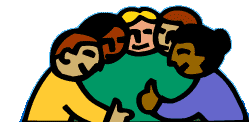Most of the people cannot talk to each other. They cannot listen to each other’s problems or offer advice or
assistance.
One-third (330) of the 1,000 people in the world village are children... half are immunized against preventable infectious
diseases such as measles and polio.
Wouldn’t it be easier if any of us could ask the situation, explain the need, and help?
Just under half of the married women in the village have access to and use modern contraceptives.
Contraception advice is sensitive and needs time and care. We could give it, if we had the words.
This year 28 babies will be born. Ten people will die, 3 of them for lack of food, 1 from cancer, 2 of the deaths are
of babies born within the year.
More people die from hunger than cancer and we do know the cure for hunger
But can we organize
it when we can’t communicate?
One person of the 1,000 is infected with the HIV virus; that person most likely has not yet developed a full-blown
case of AIDS.
AIDS doesn’t have a cure yet but we know how to avoid it. We could all know if we could tell.
With the 28 births and 10 deaths, the population of the village next year will be 1,018.
As our village becomes fuller, the need to communicate and cooperate will intensify.
In this 1,000-person community, about one-third have access to clean, safe drinking water.
Sometimes, they don’t even know that what they have is unsafe. They could boil it if we could tell them, at
least for the babies. How much easier it would be for volunteers to help provide wells if there was no language barrier.
Of the 670 adults in the village, half are illiterate.
Language education costs, and not everyone can pay. Designed simplicity is essential for equity of access.
The village has six acres of land per person, 6,000 acres in all, of which
· 700 acres are cropland
· 1,400 acres pasture
· 1,900 acres woodland
· 2,000 acres
desert, tundra, pavement and other wasteland
· The woodland is declining rapidly; the wasteland is increasing. The
other land categories are roughly stable.
The world’s understanding of landcare and conservation is concentrated in very few language groups. We can’t
cooperate if we don’t understand.
The village allocates 83 percent of its fertilizer to 40 percent of its cropland - that owned by the richest and best-fed
270 people. Excess fertilizer running off this land causes pollution in lakes and wells. The remaining 60 percent of the land,
with its 17 percent of the fertilizer, produces 28 percent of the food grains and feeds 73 percent of the people. The average
grain yield on that land is one-third the harvest achieved by the richer villagers.
The business and science of agriculture is out of reach for speakers of minority languages. People who might gladly
share their experience do not have the language skills to do it.
In the village of 1,000 people, there are:
· 5 soldiers
· 7 teachers
· 1 doctor
Many teachers spend a great deal of time teaching inefficient colonial languages to speakers of less dominant tongues.
If that were not necessary, how much more health, science and agriculture…and anything else, could be taught and learned?
· 3 refugees driven from home by war or drought
These circumstances are complex we could do without the bottle-neck of interpretation delaying procedures
for people in deep distress.
The village has a total budget each year, public and private, of over $3 million - $3,000 per person if it is distributed
evenly (which, we have already seen, it isn't).
Of the total $3 million:
· $181,000 goes to weapons and warfare
· $159,000 for education
· $l32,000 for health care
Would we still want to do this if we had the option of reaching understandings through words?
The village has buried beneath it enough explosive power in nuclear weapons to blow itself to smithereens many times
over. These weapons are under the control of just 100 of the people. The other 900 people are watching them with deep anxiety,
wondering whether they can learn to get along together; and if they do, whether they might set off the weapons anyway through
inattention or technical bungling; and, if they ever decide to dismantle the weapons, where in the world village they would
dispose of the radioactive materials of which the weapons are made.
Not that they know or could comment at the moment, but what if they could?
Would 900 heads be better than 100?
It takes just 100 hours to learn useable Esperanto, a fraction of the time needed for most language learning, even
of related languages.
Making this a priority in the parts of the world where that cost is negligible, and then helping it to become a second
language for everyone would reduce the cost of every other step we take to make ours a better world.
